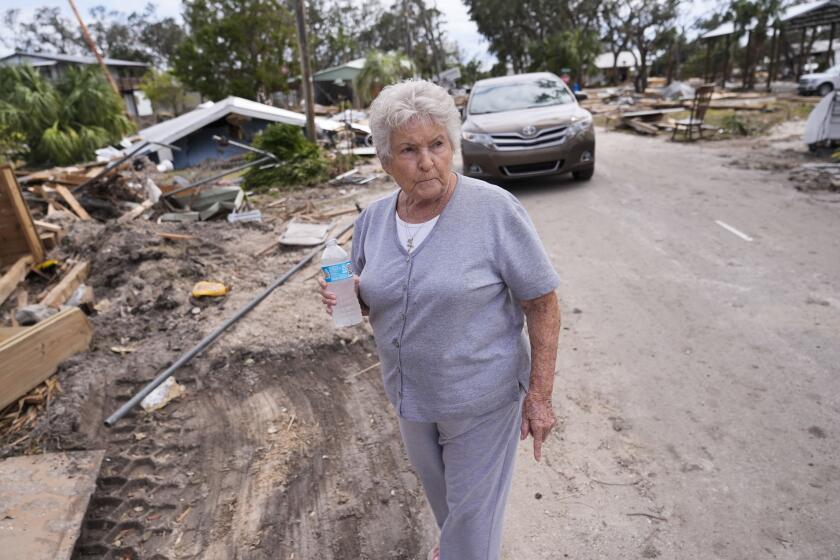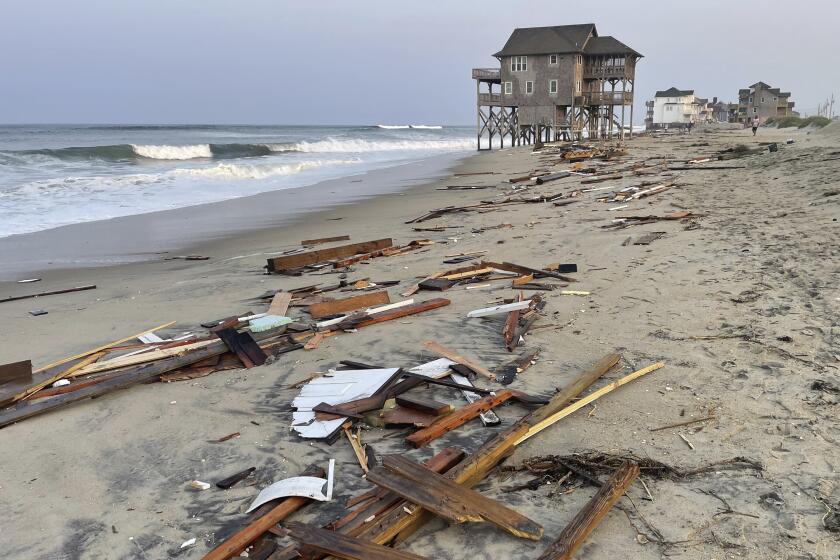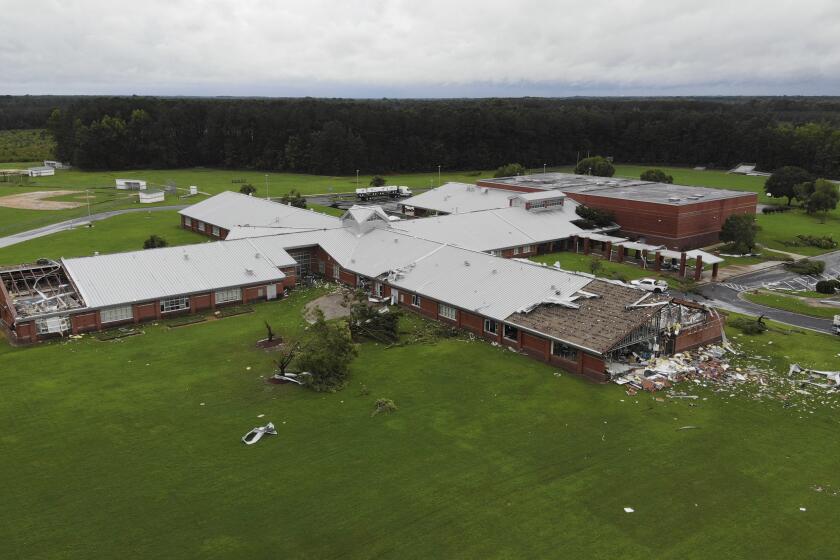Supplies arrive by plane and mule to North Carolina as Helene death toll tops 100

- Share via
ASHEVILLE, N.C. — Widespread devastation left behind by Hurricane Helene came into light Monday across the South, revealing a wasteland of splintered houses, crushed cargo containers and mud-covered highways in one of the worst storms in U.S. history.
A crisis was unfolding in western North Carolina, where residents stranded by washed-out roads and a lack of power and cellular service lined up Monday for fresh water and a chance to message loved ones that they were alive.
At least 121 deaths in six Southeastern states have been attributed to the storm — a number that climbed Monday as a clearer picture emerged of the damage it inflicted on an area stretching from Florida’s Gulf Coast northward to the Appalachian Mountains in Virginia.
North Carolina’s governor, Roy Cooper, predicted the toll would rise as rescuers and other emergency workers continue to reach areas isolated by collapsed roads, failing infrastructure and widespread flooding. During a briefing Monday, White House homeland security advisor Liz Sherwood-Randall suggested that as many as 600 people hadn’t been accounted for as of Monday afternoon, saying some might be dead.
Massive rains from powerful Helene left people stranded, without shelter and awaiting rescue around the U.S. Southeast.
Government officials and aid groups were working to bring basic supplies by airlift, truck and even mule to the hard-hit tourism hub of Asheville and its surrounding mountain towns.
The destruction and desperation were unimaginable. A flattened cargo container sat atop a bridge crossing a river coursing with muddy brown water. Overturned pontoon boats and splintered wooden docks and tree trunks covered the surface of a picturesque lake tucked between the mountains.
A woman cradled her child while people around her gathered on a hillside where they found cellphone service, many sending a simple text: “I’m OK.”
Several main routes into Asheville were washed away or blocked by mudslides, including Interstate 40, and the city’s water system was severely damaged, forcing residents to scoop creek water into buckets so they could flush toilets.
How some of the worst-hit areas are coping
In one neighborhood where a wall of water ripped away all of the trees and left behind a muddy mess, people shared food and water and comforted one another. “That’s the blessing so far in this,” Sommerville Johnston said outside her home, which has been without power since Friday.
Emergency crews are racing to rescue people trapped in flooded homes after the massive storm hit Florida as a Category 4 hurricane.
She planned on treating the neighborhood to venison stew from her powerless freezer before it goes bad. “Just bring your bowl and spoon,” she said.
Others waited in a line for more than a block at Mountain Valley Water, a water seller, to fill up milk jugs and whatever other containers they could find.
Derek Farmer, who brought three gallon-sized apple juice containers, said he had been prepared for the storm but now was nervous after three days without water. “I just didn’t know how bad it was going to be,” Farmer said.
Officials warned that rebuilding from the widespread loss of homes and property would be slow and difficult. The storm upended life throughout the Southeast, where deaths were also reported in Florida and Virginia.
Video showed a mass of debris, including overturned pontoon boats and splintered wooden docks, covering the surface of Lake Lure, a picturesque spot tucked among the mountains outside Asheville.
Hurricane Helene has strengthened into a Category 4 storm as it races toward northwest Florida and causes flooding on the Gulf Coast and power outages inland.
Helene roared ashore in northern Florida late Thursday as a Category 4 hurricane and quickly moved through Georgia, the Carolinas and Tennessee with torrential rains that flooded waterways.
Federal Emergency Management Agency officials said Monday that hundreds of roads were closed across western North Carolina and that shelters were housing more than 1,000 people.
Cooper implored area residents to avoid travel for their own safety and to keep the roads clear for emergency vehicles. More than 50 search teams spread throughout the region in search of stranded people.
Waiting for help and searching for a signal in North Carolina
Several dozen people gathered on high ground in Asheville, where they found one of the city’s hottest commodities — a cellular phone signal.
“Is this Day 3 or Day 4?” Colleen Burnet asked. “It’s all been a blur.”
The storm unleashed the worst flooding in a century in North Carolina. Rainfall estimates in some areas topped more than 2 feet since Wednesday.
President Biden said Monday that the federal government would be with survivors and others affected by Helene “as long as it takes.”
The last time the Atlantic failed to produce any named storms between Aug. 13 and Sept. 3 was in 1968 — more than 50 years ago.
He expected to ask Congress for additional money for disaster assistance and intends to travel to North Carolina later this week when his presence wouldn’t divert from live-saving search-and-rescue missions.
Ten federal search-and-rescue teams were on the ground and another nine were on their way, while trucks and cargo planes were arriving with food and water, FEMA said.
FEMA Administrator Deanne Criswell surveyed damage with Cooper on Monday.
Volunteers were showing up too. Mike Toberer decided to bring a dozen of his mules to deliver food, water and diapers to the hard-to-reach mountainous areas.
“We’ll take our chain saws, and we’ll push those mules through,” he said, noting that each one can carry about 200 pounds and travel 2 mph.
Why western North Carolina was hit so hard
Western North Carolina suffered relatively more devastation because that’s where the remnants of Helene encountered the higher elevations and cooler air of the Appalachian Mountains, causing even more rain to fall.
Tropical Storm Debby spawned deadly tornadoes in North Carolina. In New York, drones with loudspeakers warned people in basement apartments to be ready to flee.
Asheville and many surrounding towns were built in valleys, leaving them especially vulnerable to devastating rain and flooding from rain at higher elevations. Plus, the ground already was saturated before Helene arrived, said Christiaan Patterson, a meteorologist with the National Weather Service.
“By the time Helene came into the Carolinas, we already had that rain on top of more rain,” Patterson said.
Climate change has exacerbated conditions that allow such storms to thrive, rapidly intensifying in warming waters and turning into powerful cyclones, sometimes within hours.
Destruction from Florida to Virginia
Along Florida’s Gulf Coast, several feet of water swamped the Clearwater Marine Aquarium, forcing workers to move two manatees and sea turtles. All of the animals were safe but much of the aquarium’s vital equipment was damaged or destroyed, said James Powell, the aquarium’s executive director.
Georgia’s governor, Brian Kemp, said the storm “literally spared no one.” Most people in and around Augusta, a city of about 200,000 people near the South Carolina border, were still without power Monday, and Kemp and other officials tried to reassure residents that they felt their misery.
With at least 25 killed in South Carolina, Helene was the deadliest tropical cyclone to hit the state since Hurricane Hugo made landfall north of Charleston in 1989, killing 35 people.
Tropical Storm Kirk forms and could become a powerful hurricane
Meanwhile, Tropical Storm Kirk formed Monday in the eastern Atlantic Ocean and is expected to become a “large and powerful hurricane” by Tuesday night or Wednesday, the National Hurricane Center said. The storm was about 700 miles west of the Cabo Verde Islands with maximum sustained winds of 45 mph. There were no coastal watches or warnings in effect, and the storm system was not a threat to land.
Collins writes for the Associated Press. AP reporters John Seewer in Toledo, Ohio; Ben Finley in Norfolk, Va.; Beatrice Dupuy in New York City and Jeff Amy in Atlanta contributed to this report.
More to Read
Sign up for Essential California
The most important California stories and recommendations in your inbox every morning.
You may occasionally receive promotional content from the Los Angeles Times.














